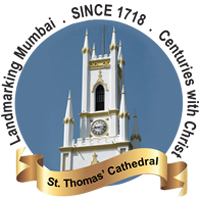Our Church, The Cathedral of St. Thomas the Apostle, was established in 1718 at Fort Mumbai (then Bombay) by the Anglican Church (Church of England) to providing a place of worship as well as Pastoral/Episcopal care in the city (then town) of Bombay.
Thereafter it is half a century long history from the conception of the idea of building this church in 1668 to its completion in 1718. It involved the vision, dedicated efforts and generous contributions from many faithful Christians who wanted a place of worship in Bombay in the tradition of the Church of England.
Origin
The
idea of building a church was conceived by Sir John Oxinden, the
East India Company’s first Governor of Bombay in 1668. He was an
intensely religious man who foresaw the religious needs of his men
and thought of building a church in Bombay. Gerald
Aungier, who succeeded him in 1669, pursued Oxinden’s wish.
Aungier introduced a definitive religious policy in India and he
wanted to invite the natives and strangers to embrace the reverence
of the wholly reformed religion and see their form of worship. An
amount of Rs. 50000 was raised by voluntary contribution from
the servants of East India Company and was handed over to the
chaplains of Bombay to build the church. Most of these
contributions were by people who came forward offering their full
year’s wages, some half year’s and least a quarter. Foundation
of the church was laid in the present site in 1676 and the work
continued for 3 years during the governorship of Sir John Child who
succeeded Aungier in 1677. The
church walls were raised to a height of 15 feet, but the work was
then suspended since the English community had several setbacks
after Aungier’s death in 1677. This project to build the church
remained at a standstill for over 30 years.
Richard
Cobbe who was appointed as the Chaplain to the factory of Bombay to
the Merchants of England in 1714 campaigned aggressively for the
resumption of building and completion of the church. Cobbe proposed
the building of the church in his sermon on the Sunday after Trinity
in June, 1715. That sermon had a great impact and Cobbe was granted
leave to build the church. The Governor and the East India Company
were the first ones to generously contribute towards the building. On
18 November 1715 the foundation stone for the church was laid once
again on the same site as the old church by Stephen Strutt , Deputy
Governor of Bombay. The
church building was ready for opening in December, 1718.The church
was inaugurated on Christmas Day in 1718 by Charles Boone, the
Governor of Bombay in a grand ceremony.

The
Church Structure
Following
excerpts from Cobbe’s letter to Robert Adams the chief of Calicut
in January, 1718 give a description of the church building, “ …
As to the church itself, it is indeed a structure deservedly admired
for its beauty, neatness and uniformity, but more especially for its
echo; the roof of it being arched with three regular arches of stone
supported by two pillars and pilasters on each of side, a large semi
dome at the east to receive communion table as that of St. Paul’s
London, ascending by three steps and a railing separating it from the
body of the Church…The Bombay church was planned to hold a
congregation of 1,000 people.”
In
1860 a major plan was formulated for the restoration of the Cathedral
and the project was spearheaded by the Senior Chaplain Rev. W. K.
Fletcher from 1860–1867 with support from private contributions and
government aid. We would not have seen today the grand eastern wing
of the Cathedral as we see today had Fletcher and the other trustees
not taken the bold step to commence the renovation activity.
The
architecture of the building has undergone numerous transformations
overtime with multiple additions and alterations that respected the
integrity of the previous designs.
Name
of the Church
In
December, 1718 Richard Cobbe wrote to Dr. Robinson who was the Bishop
of London requesting orders for the consecration of the Church and
begging his Lordship to suggest a name for the church which
unfortunately never happened.
Church
Congregation & Diocese
St
Thomas' Cathedral congregation has been consistently worshipping on
the premises since the year 1718. Till the mid-1950s the Cathedral
had a fairly large British congregation and an English priest. With
the departure of British and Anglo Indians from India their numbers
and prominence in the congregation began to decline. As the typically
British atmosphere in the church diminished an increasing number of
Indian Christians began to worship. These Christians were and still
are mainly professionals from various Indian church denominations.
Thus, the congregation that worships in St. Thomas’ Cathedral today is protestant cross denominational.
The
Church came into the administration of the erstwhile Bombay Diocese
from 1837 when Archdeacon Carr was appointed as the first Bishop of
Bombay. In 1838 the Church was named as St. Thomas
Cathedral being the Seat of Bishop of Bombay. In 1970 the Anglican
Church (Church of England) joined the Union of the Church of North
India along with other Protestant Churches.
St.
Thomas' Cathedral came under the administration and control of Bombay
Diocesan Council. The Bombay Diocese is one of the Dioceses of the
Church of North India which was formed as a United Church on 29
November 1970 at Nagpur. St. Thomas Cathedral is one of the Churches
of the Bombay Diocese and is governed by the Provisions of the
Constitution of the Church of North India and its bylaw as well as
the bylaws of the Bombay Diocesan Council.
Ever since, this majestic building built with a definitive purpose has been attracting christian worshippers and non-christians alike. Every week day our Church gates are open to tourists, people from all religions and walks of life who walk in to find peace and tranquility.





